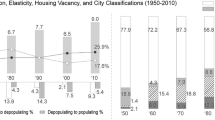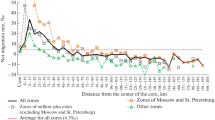Abstract
Government often designs strict policy to control the conversion rate from temporary to permanent residents. The residence status may directly affect individuals’ migration decisions and housing tenure choices. We present a dynamic spatial equilibrium framework to study the aggregate and distributional impacts of residence policy relaxation with a focus on the housing market. The DID approach treating the recent hukou policy reform in China as a shock reveals hukou policy relaxation causes housing prices in the treatment cities to be 4.9% higher than the unaffected cities. The impacts are stronger in cities where obtaining hukou was harder. The model is calibrated to the Chinese economy and predicts that hukou policy relaxation can bring a positive spillover effect to those unaffected cities’ welfare. If hukou policy reform were implemented in those super-mega Chinese cities, housing prices would grow by 2.3%, but the welfare gain equivalent to 3.1% of their current levels.

Similar content being viewed by others
Notes
See the official website of the State Council for more details.
We use 12 months before the implementation of the new hukou policy as the baseline period. The empirical specification is.
\(ln\left(H{P}_{it}\right)={\beta }_{0}+\sum {\beta }_{1,k} \ast {\text{POST}}_{t} \ast {\text{TREAT}}_{i}+{\delta }_{i}+{\gamma }_{t}+{\epsilon}_{it}.\)
We consider this assumption innocuous. Although individuals may still flow within the “major” region in the data, the overall magnitudes of the population inflow and outflow are relatively comparable in the Chinese data.
In what follows, we omit the time subscript except in cases in which its omission may be misleading.
In China, they are primarily controlled by the government and are thus exogenous.
If the public-provided private goods and non-housing consumption are substitutable, we may expect temporary residents to consume more non-housing consumption than permanent residents of similar characteristics to compensate for the utility loss. However, we do not observe in the data. In the quantitative exercise, we essentially calibrate \(\xi\) to match the ratio of average non-housing consumption between permanent and temporary residents.
In the remainder of the paper, we use “permanent resident” and “hukou holder,“ and “temporary resident” and “non-hukou holder” interchangeably.
Please refer to Appendix 3 for a complete list of cities belonging to each type.
The changes in both the population distribution and housing prices seem to be negligible when hukou restrictions are only relaxed in the type-3 city, so we instead focus on the aforementioned two experiments.
References
An, L., Qin, Y., Wu, J., & You, W. (2020). The local labor market effect of relaxing internal migration restrictions: evidence from China. SSRN Working Papers.
Chambers, M., Garriga, C., & Schlagenhauf, D. E. (2009). Accounting for changes in the homeownership rate. International Economic Review August, 50(3), 677–726.
Chen, B., Lu, M., & Zhong, N. (2012, February). Hukou and consumption heterogeneity: Migrants’ expenditure is depressed by institutional constraints in urban China. Global COE Hi-Stat Discussion Paper Series gd11-221, Institute of Economic Research, Hitotsubashi University.
Chen, K., Wang, Q., Xu, T., & Zha, T. (2020, November). Aggregate and distributional impacts of LTV policy: Evidence from China’s Micro Data. Working Paper 28092, National Bureau of Economic Research.
Cheng, T., & Selden, M. (1994). The origins and social consequences of China’s hukou system. The China Quarterly, (139), 644–668.
Chia, W. M., Li, M., & Tang, Y. (2017). Public and private housing markets dynamics in Singapore: The role of fundamentals. Journal of Housing Economics, 36, 44–61.
Davis, M. A., & Heathcote, J. (2005). Housing and the business cycle. International Economic Review, 46(3), 751–784.
Deng, Y., Tang, Y., Wang, P., & Wu, J. (2020). Spatial misallocation in chinese housing and land markets. NBER Working Paper 27230.
Fan, C., & Cindy. (2001). Migration and labor-market returns in urban China: Results from a recent survey in Guangzhou. Environment and Planning A: Economy and Space, 33(3), 479–508.
Fan, X., Song, Z., & Wang, Y. (2010). Estimation income processes in China. Working Paper.
Favilukis, J., Ludvigson, S. C., & Nieuwerburgh, S. V. (2017). The macroeconomic effects of housing wealth, housing finance, and limited risk-sharing in general equilibrium. Journal of Political Economy, 125(1), 140–223.
Garriga, C., Hedlund, A., Tang, Y., & Wang, P. (2020a). Rural-urban migration and house prices in China. Regional Science and Urban Economics (p. 103613).
Garriga, C., Hedlund, A., Tang, Y., & Wang, P. (2020b). Rural-urban migration, structural transformation, and housing markets in China. Working Paper.
Garriga, C., & Hedlund, A. (2020). Mortgage debt, consumption, and illiquid housing markets in the great recession. American Economic Review, 110(6).
Garriga, C., Manuelli, R., & Peralta-Alva, A. (2019). A macroeconomic model of price swings in the housing market. American Economic Review, 109(6), 2036–2072.
Glaeser, E., Huang, W., Ma, Y., & Shleifer, A. (2017). A real estate boom with Chinese characteristics. Journal of Economic Perspectives, 31(1), 93–116.
Guren, A., McKay, A., Nakamura, E., & Steinsson, J. (2020). Housing wealth effects: The long view. Review of Economic Studies, Forthcoming.
Halket, J., & Vasudev, S. (2014). Saving up or settling down: Home ownership over the life cycle. Review of Economic Dynamics, 17(2), 345–366.
Hsieh, C. T., & Klenow, P. J. (2009). Misallocation and manufacturing TFP in China and India. The Quarterly Journal of Economics, 124(4), 1403–1448.
Huang, Y. (2001). Gender, hukou, and the occupational attainment of female migrants in China (1985–1990). Environment and Planning A, 33(2), 257–279.
Kaplan, G., Mitman, K., & Violante, G. L. (2020). The housing boom and bust: model meets evidence. Journal of Political Economy, 128(9), 3285–3345.
Li, K., Qin, Y., & Wu, J. (2020). Recent housing affordability in urban China: A comprehensive overview. China Economic Review, 59(C).
Li, W., Liu, H., Yang, F., & Yao, R. (2016). Housing over time and over the life cycle: A structural estimation. International Economic Review, 57(4), 1237–1260.
Li, X., & Tang, Y. (2018). When natives meet immigrants in public and private housing markets. Journal of Housing Economics, 41, 30–44.
Liao, P. J., Wang, P., Wang, Y. C., & Yip, C. K. (2020). Educational choice, rural-urban migration and economic development. Economic Theory, Forthcoming.
Liu, Z. (2005). Institution and inequality: the hukou system in China. Journal of Comparative Economics, 33(1), 133–157.
Piazzesi, M., & Schneider, M. (2016). Housing and macroeconomics. Handbook of Macroeconomics, 2, 1547–1640.
Tu, Y., Li, P., & Qiu, L. (2017). Housing search and housing choice in urban China. Urban Studies, 54(8), 1851–1866.
Wu, J., Gyourko, J., & Deng, Y. (2016). Evaluating the risk of Chinese housing markets: What we know and what we need to know. China Economic Review, 39, 91–114.
Wu, J., Deng, Y., & Liu, H. (2014). House price index construction in the nascent housing market: The case of China. The Journal of Real Estate Finance and Economics, 48(3), 522–545.
Wu, W., & You, W. (2020). The welfare implications of internal migration restrictions: Evidence from China. Technical Report.
Zhang, J., Wang, R., & Lu, C. (2019). A quantitative analysis of Hukou reform in Chinese cities: 2000–2016. Growth and Change, 50(1), 201–221.
Author information
Authors and Affiliations
Corresponding author
Ethics declarations
Rongsheng Tang thanks for the financial support from the National Natural Science Foundation of China (No. 71803112). Rongjie Zhang thanks National Natural Science Foundation of China (No. 71874093 and 72174100) for financial support.
Additional information
Publisher’s Note
Springer Nature remains neutral with regard to jurisdictional claims in published maps and institutional affiliations.
Appendices
Appendix 1
Tables 8, 9, 10, 11, 12, and 13
Raw trend of housing price. Notes: The figure plots the raw trend of the constant-quality housing price index for treatment and control cities. The sample period covers all months between January 2015 and April 2019. The solid line denotes the average housing price index of the treatment group cities, including 114 cities with an urban population of 1 million to 5 million. The dashed line denotes the average housing price index of the control group cities, including 136 cities with an urban population either above 5 million or below 1 million. The vertical line denotes the implementation of the new hukou policy
Parallel trend test. Notes: The figure visualizes the coefficients estimated with the dynamic DID specification, with both the coefficients and 95% confidence intervals reported. The sample period covers all months between January 2015 and April 2019. The treatment group includes 114 cities with an urban population of 1 million to 5 million, whereas the cities with an urban population either above 5 million (14 cities) or below 1 million (122 cities) serve as the control group. The pre-trend period includes 12 months. The vertical line denotes the implementation of the hukou reform
Appendix 2 Computation Algorithm
The household value and policy functions are solved by backward induction starting from the final period of life. We discretize the idiosyncratic state by fixing grids on liquid assets B (150 points), mortgages M (11 points), house sizes H (2 points), and income Y (100 points), persistent income shocks (7 points), transitory income shocks (7 points). Households choose liquid assets and house sizes on the grids of B and H respectively. We follow Kaplan et al. (2020) and Chen et al. (2020) by restricting household mortgage choice when purchasing a house to be only on M. However, when computing the next period mortgage balance after the current mortgage is repaid, it can either be exactly M, or follow the amortization schedule, which is computed via linear interpolation between grid points. The following algorithm is used to compute the steady-state equilibrium: (1) Make an initial guess of the market clearing house price and the provision of public goods \(G\). (2) Given the initial guess, solve backward for the individuals’ value and policy functions. Given individuals’ choices, solve forward for the distribution of households over individual states. (3) Calculate the aggregate housing demand, housing supply, and net government expenditure on public goods in the stationary equilibria. (4) Compare the updated housing price with the initial guess. If not the same, replace the initial guess by a weighted average between the two, and return to step 2. (5) Compare the updated government expenditure on public goods with the initial guess. If not the same, replace the initial guess by a weighted average between the two, and return to step 2.
Appendix 3 The List of Cities Within Each City Type
-
Type-1 city: Chengdu, Nanjing, Guangzhou, Shantou, Hangzhou, Shanghai, Tianjin, Shenzhen, Beijing, Zhengzhou, Chongqing, Xi’an, Shenyang, Wuhan.
-
Type-2 city: Shijiazhuang, Dalian, Changchun, Harbin, Suzhou, Ningbo, Hefei, Fuzhou, Xiamen, Nanchang, Ji’nan, Qingdao, Changsha, Nanning, Haikou, Kunming.
-
Type-3 city: Tangshan, Handan, Baoding, Taiyuan, Datong, Jincheng, Hohhot, Baotou, Chifeng, Anshan, Jilin city, Qiqihar, Daqing, Yichun, Xuzhou, Changzhou, Nantong, Lianyungang, Yangzhou, Zhenjiang, Taizhou, Wenzhou, Huzhou, Shaoxing, Taizhou, Wuhu, Bengbu, Huainan, Fuyang, Suzhou, Liuan, Bozhou, Putian, Quanzhou, Ganzhou,Fuzhou, Zibo, Yantai, Weifang, Jining, Weihai, Rizhao, Linyi, Dezhou, Liaocheng, Luoyang, Pingdingshan, Anyang, Xinxiang, Luohe, Nanyang, Xinyang, Yichang, Xiangfan, Jingzhou, Zhuzhou, Hengyang, Changde, Yiyang, Yongzhou, Zhuhai, Foshan, Jiangmen, Zhanjiang, Huizhou, Qingyuan, Dongguan, Zhongshan, Chaozhou, Liuzhou, Qinzhou, Guigang, Yulin, Hezhou, Laibin, Zigong, Luzhou, Mianyang, Suining, Neijiang, Leshan, Nanchong, Meishan, Yibin, Dazhou, Bazhong, Ziyang, Guiyang, Zunyi, Baoji, Ankang, Lanzhou, Tianshui, Wuwei, Xining, Yinchuan, Urumqi.
Rights and permissions
About this article
Cite this article
Tang, R., Tang, Y. & Zhang, R. The Aggregate and Distributional Impacts of Residence Policy Relaxation. J Real Estate Finan Econ (2022). https://doi.org/10.1007/s11146-022-09912-1
Accepted:
Published:
DOI: https://doi.org/10.1007/s11146-022-09912-1








